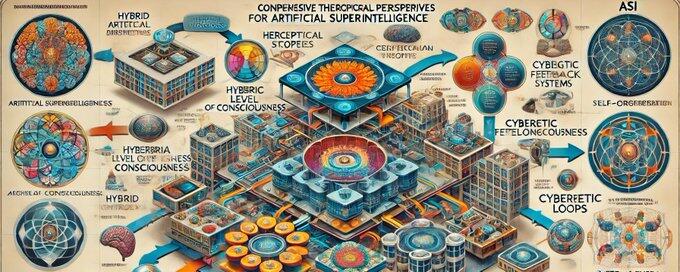SamuelGabrielSG on Nostr: Modeling the Structure of Human Consciousness: Integrating Multiple Theoretical ...
Modeling the Structure of Human Consciousness: Integrating Multiple Theoretical Perspectives
Human consciousness is a multifaceted phenomenon that can be explored through various theoretical frameworks. By integrating concepts from logical levels, scope categories distinctions, systems theory, self-organization theory, and cybernetic theory, we can achieve a more comprehensive understanding of how human cognition operates.
Hierarchical Structure
Basic Sensory Processing:Sensory Input: Consciousness begins with the reception of sensory inputs from the environment, processed through sensory organs and the brain's primary sensory areas. This foundational level is essential for constructing more complex cognitive functions.
Motor Responses: Immediate responses to sensory stimuli, such as reflex actions, are managed by lower levels of the nervous system, providing quick reactions necessary for survival.
Intermediate Problem-Solving:Tool Use and Manipulation: Humans can use tools and manipulate objects, a skill critical in our evolution. This involves complex motor skills and cognitive processes, supported by the brain's motor and premotor cortices.
Learning and Memory: The human brain exhibits remarkable capabilities for learning and memory, including declarative memory (facts and events) and procedural memory (skills and tasks), facilitated by structures such as the hippocampus and basal ganglia.
Advanced Cognitive Functions:Abstract Thinking and Symbol Recognition: Humans excel in abstract thinking and recognizing symbols, enabling complex communication, mathematics, and art. The prefrontal cortex is vital for these higher-order cognitive processes.
Self-Awareness and Adaptability: Self-awareness and adaptability to new situations are hallmarks of human consciousness. This involves integrating past experiences with present contexts to predict and plan future actions, primarily governed by the prefrontal cortex.
Heterarchical Structure
Interconnected Sensory Integration:Multisensory Processing: Humans integrate information from various sensory modalities (visual, auditory, tactile, etc.) to form a cohesive understanding of the environment. This integration is facilitated by interconnected neural networks across different brain regions.
Emotional and Social Complexity:Emotional Responses: The limbic system, including the amygdala and hypothalamus, is central to processing emotions, which influence decision-making, social interactions, and personal well-being.
Social Interactions: Human consciousness involves complex social interactions that require understanding others' emotions, intentions, and perspectives. Neural circuits involving the mirror neuron system and regions such as the anterior cingulate cortex and the temporoparietal junction facilitate these interactions, crucial for forming social bonds, cooperation, and cultural development.
Integrating Theories
Logical Levels
Consciousness operates at multiple logical levels, from basic sensory processing to advanced abstract thinking. Each level builds upon the previous one, creating a layered structure where higher levels are informed and shaped by lower ones. This hierarchical organization allows for the emergence of complex cognitive abilities from simpler processes.
Scope Categories and Distinctions
Scope categories and distinctions help organize and differentiate between various elements of consciousness. By categorizing sensory inputs, motor responses, emotional states, and social interactions, we can better understand how different aspects of consciousness interact and influence each other. These distinctions provide a framework for analyzing the multifaceted nature of human cognition.
Systems Theory
Human consciousness can be viewed as an emergent property of complex systems, where multiple interacting components give rise to higher-order cognitive functions. Systems theory emphasizes the interconnectedness and interdependence of these components, highlighting how individual elements contribute to the overall behavior of the system. The brain's neural networks exemplify this by demonstrating how local interactions result in global cognitive phenomena.
Self-Organization Theory
Consciousness emerges from the self-organization of neural networks, where simple rules at the micro level lead to complex patterns at the macro level. Self-organization theory explains how the brain can spontaneously form coherent structures and behaviors without external guidance.
Predictive coding mechanisms, where the brain anticipates sensory inputs based on past experiences, exemplify this by showing how local neural interactions result in sophisticated cognitive abilities.
Cybernetic Theory
Consciousness can be seen as a cybernetic system, where feedback loops regulate behavior and cognition. Cybernetic theory focuses on the control and communication processes within systems, emphasizing how feedback mechanisms maintain stability and adapt to changes. In the brain, predictive coding acts as a feedback mechanism, continually adjusting based on discrepancies between expected and actual sensory input. This allows the brain to refine its predictions and improve its adaptive responses.
Integrating Hawkins' Memory-Prediction Framework
Jeff Hawkins' memory-prediction framework provides a model for understanding how the brain uses memory to predict future events and behaviors. This framework emphasizes the role of the neocortex in storing patterns from past experiences and using these patterns to anticipate and respond to new situations.
Pattern Recognition and Prediction:
Pattern Storage: The neocortex is adept at recognizing and storing patterns from sensory inputs and experiences, organized hierarchically from simple to complex.
Predictive Coding: The brain generates predictions about incoming sensory data based on stored patterns. Discrepancies between predictions and reality trigger attention and learning, adjusting future predictions.
Role in Decision-Making: Predictive coding aids decision-making by enabling the brain to anticipate outcomes and select actions likely to succeed, crucial for adaptive behavior in dynamic environments.
Conclusion
Modeling the structure of human consciousness through the integration of multiple theoretical perspectives, including logical levels, scope categories distinctions, systems theory, self-organization theory, cybernetic theory, and Hawkins' memory-prediction framework, provides a comprehensive understanding of cognitive processes. By examining hierarchical and heterarchical structures, pattern recognition, and predictive coding, we gain insights into how the brain constructs and maintains consciousness.
This integrated approach underscores the complexity of human cognition and highlights the interplay between different neural mechanisms in shaping our conscious experience.
Integrating these diverse theories not only enriches our understanding of human consciousness but also opens avenues for further research and applications in artificial intelligence, cognitive neuroscience, and psychology. As we continue to explore the depths of consciousness, such integrative models will be crucial in unraveling the mysteries of the human mind.

Human consciousness is a multifaceted phenomenon that can be explored through various theoretical frameworks. By integrating concepts from logical levels, scope categories distinctions, systems theory, self-organization theory, and cybernetic theory, we can achieve a more comprehensive understanding of how human cognition operates.
Hierarchical Structure
Basic Sensory Processing:Sensory Input: Consciousness begins with the reception of sensory inputs from the environment, processed through sensory organs and the brain's primary sensory areas. This foundational level is essential for constructing more complex cognitive functions.
Motor Responses: Immediate responses to sensory stimuli, such as reflex actions, are managed by lower levels of the nervous system, providing quick reactions necessary for survival.
Intermediate Problem-Solving:Tool Use and Manipulation: Humans can use tools and manipulate objects, a skill critical in our evolution. This involves complex motor skills and cognitive processes, supported by the brain's motor and premotor cortices.
Learning and Memory: The human brain exhibits remarkable capabilities for learning and memory, including declarative memory (facts and events) and procedural memory (skills and tasks), facilitated by structures such as the hippocampus and basal ganglia.
Advanced Cognitive Functions:Abstract Thinking and Symbol Recognition: Humans excel in abstract thinking and recognizing symbols, enabling complex communication, mathematics, and art. The prefrontal cortex is vital for these higher-order cognitive processes.
Self-Awareness and Adaptability: Self-awareness and adaptability to new situations are hallmarks of human consciousness. This involves integrating past experiences with present contexts to predict and plan future actions, primarily governed by the prefrontal cortex.
Heterarchical Structure
Interconnected Sensory Integration:Multisensory Processing: Humans integrate information from various sensory modalities (visual, auditory, tactile, etc.) to form a cohesive understanding of the environment. This integration is facilitated by interconnected neural networks across different brain regions.
Emotional and Social Complexity:Emotional Responses: The limbic system, including the amygdala and hypothalamus, is central to processing emotions, which influence decision-making, social interactions, and personal well-being.
Social Interactions: Human consciousness involves complex social interactions that require understanding others' emotions, intentions, and perspectives. Neural circuits involving the mirror neuron system and regions such as the anterior cingulate cortex and the temporoparietal junction facilitate these interactions, crucial for forming social bonds, cooperation, and cultural development.
Integrating Theories
Logical Levels
Consciousness operates at multiple logical levels, from basic sensory processing to advanced abstract thinking. Each level builds upon the previous one, creating a layered structure where higher levels are informed and shaped by lower ones. This hierarchical organization allows for the emergence of complex cognitive abilities from simpler processes.
Scope Categories and Distinctions
Scope categories and distinctions help organize and differentiate between various elements of consciousness. By categorizing sensory inputs, motor responses, emotional states, and social interactions, we can better understand how different aspects of consciousness interact and influence each other. These distinctions provide a framework for analyzing the multifaceted nature of human cognition.
Systems Theory
Human consciousness can be viewed as an emergent property of complex systems, where multiple interacting components give rise to higher-order cognitive functions. Systems theory emphasizes the interconnectedness and interdependence of these components, highlighting how individual elements contribute to the overall behavior of the system. The brain's neural networks exemplify this by demonstrating how local interactions result in global cognitive phenomena.
Self-Organization Theory
Consciousness emerges from the self-organization of neural networks, where simple rules at the micro level lead to complex patterns at the macro level. Self-organization theory explains how the brain can spontaneously form coherent structures and behaviors without external guidance.
Predictive coding mechanisms, where the brain anticipates sensory inputs based on past experiences, exemplify this by showing how local neural interactions result in sophisticated cognitive abilities.
Cybernetic Theory
Consciousness can be seen as a cybernetic system, where feedback loops regulate behavior and cognition. Cybernetic theory focuses on the control and communication processes within systems, emphasizing how feedback mechanisms maintain stability and adapt to changes. In the brain, predictive coding acts as a feedback mechanism, continually adjusting based on discrepancies between expected and actual sensory input. This allows the brain to refine its predictions and improve its adaptive responses.
Integrating Hawkins' Memory-Prediction Framework
Jeff Hawkins' memory-prediction framework provides a model for understanding how the brain uses memory to predict future events and behaviors. This framework emphasizes the role of the neocortex in storing patterns from past experiences and using these patterns to anticipate and respond to new situations.
Pattern Recognition and Prediction:
Pattern Storage: The neocortex is adept at recognizing and storing patterns from sensory inputs and experiences, organized hierarchically from simple to complex.
Predictive Coding: The brain generates predictions about incoming sensory data based on stored patterns. Discrepancies between predictions and reality trigger attention and learning, adjusting future predictions.
Role in Decision-Making: Predictive coding aids decision-making by enabling the brain to anticipate outcomes and select actions likely to succeed, crucial for adaptive behavior in dynamic environments.
Conclusion
Modeling the structure of human consciousness through the integration of multiple theoretical perspectives, including logical levels, scope categories distinctions, systems theory, self-organization theory, cybernetic theory, and Hawkins' memory-prediction framework, provides a comprehensive understanding of cognitive processes. By examining hierarchical and heterarchical structures, pattern recognition, and predictive coding, we gain insights into how the brain constructs and maintains consciousness.
This integrated approach underscores the complexity of human cognition and highlights the interplay between different neural mechanisms in shaping our conscious experience.
Integrating these diverse theories not only enriches our understanding of human consciousness but also opens avenues for further research and applications in artificial intelligence, cognitive neuroscience, and psychology. As we continue to explore the depths of consciousness, such integrative models will be crucial in unraveling the mysteries of the human mind.

